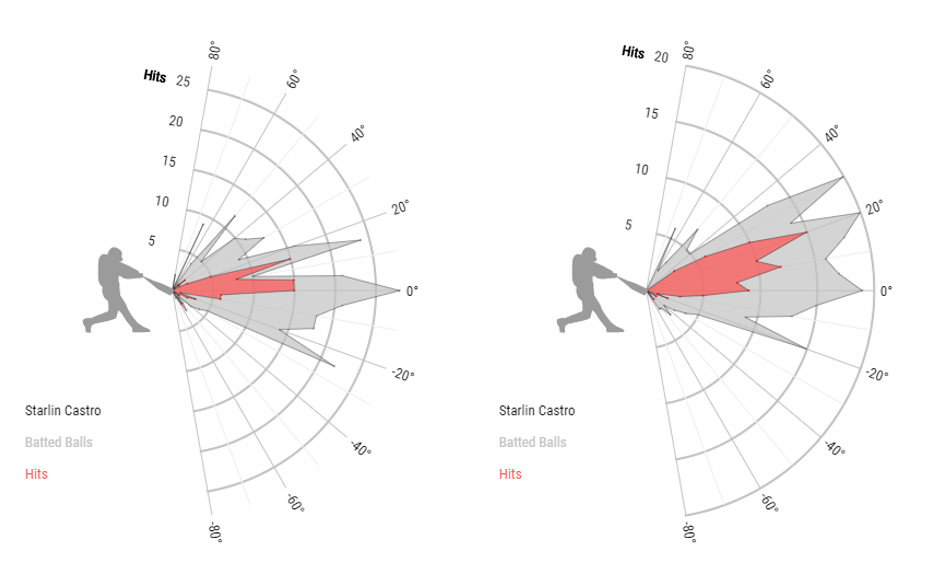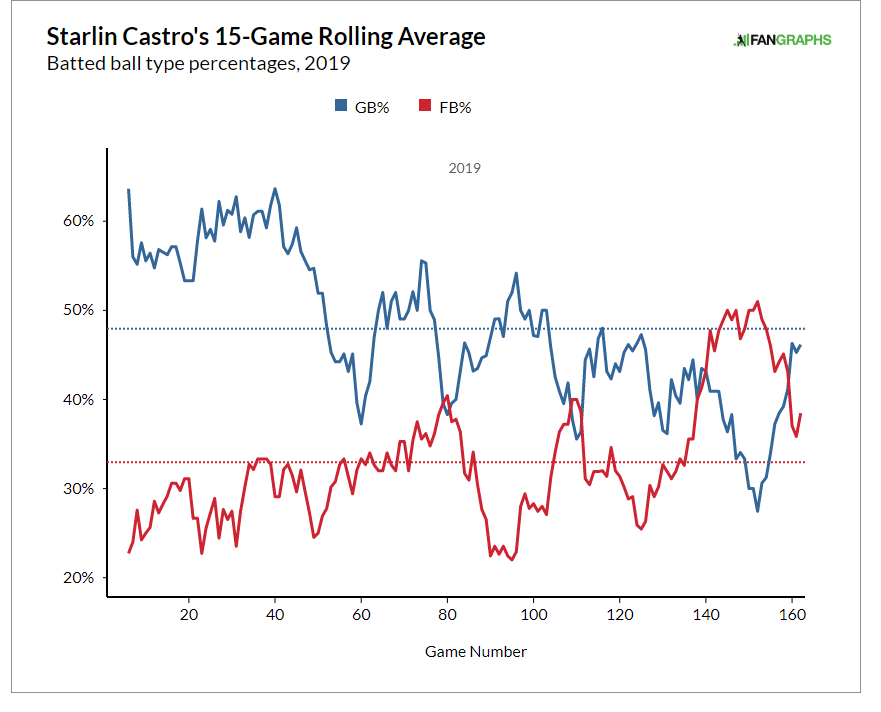It feels like it’s been a long time since we really cared a lot about Starlin Castro for fantasy baseball. That’s because it was a long time ago, or at least, relatively, because fantasy players have an incredibly short memory.
Castro’s fantasy value has jumped around quite a bit over the years. During his first few seasons with the Chicago Cubs, he was a 20+ steal, high-average, low double-digit home runs guy. Then, all of a sudden, the speed went away, and he was just a high-average, 10-14 home run guy, which was pretty boring.
Then, he ends up on the New York Yankees and decides he might goof off a little and hit for some power, launching a career-best 21 home runs while hitting .270. The exciting rebound of Starlin Castro!
His 2017 season with the Yankees wasn’t as good, but he was still useful, and then he ends up on the Miami Marlins, where he languishes in a pitcher’s park on a bad team, barely owned in most fantasy leagues.
Still, Castro was productive, and last year, he was especially so, putting up arguably one of the best seasons of his career, slashing .270/.300/.436 with 22 home runs, 68 runs, and 86 RBI.
What’s more, he didn’t look that good in the first half of the year, slashing just .245/.272/.336 during that time. But once the All-Star break ended, Castro went on a tear, suddenly slashing .302/.334/.558. What gives?
Castro’s Midseason Adjustment
It wasn’t just blind luck that Starlin Castro suddenly was lighting up the league in the second half of the season. He made an adjustment to his approach, and one that it seems to have helped immensely.
The change is pretty noticeable when you see it side-by-side. Take a look below: His batting stance in the first half of last year is on the left, with the second half on the right.

Pretty easy to see, right? Castro opened up his swing last year, shifting his front foot over. But it wasn’t just his batting stance; it was his whole approach that changed. He’s decided to lean into the launch angle movement, adding a bit of an uppercut to his swing to focus on hitting more fly balls than ground balls.
And the results were pretty noticeable — take a look at Castro’s launch angle during the first half of the season (on the left) compared to his launch angle during the second half (on the right).

Castro saw his average launch angle increased from 9.4 degrees to 12.7 degrees, which is a pretty big change, and one that’s very good for Castro’s production. As a result of this change, Castro saw his ground ball rate drop and his fly ball rate increase pretty noticeably.

Specifically, Castro saw his ground ball rate drop from 52.1% in the first half to 43% in the second half, his line drive rate increase from 17.5% to 21.1%, his fly ball rate increase from 30.5% to 36%, and his HR/FB rate increase from 6.7% to 18.4%. So, in other words, Castro started hitting the ball on the ground a lot less and started lofting it in the air more, resulting in more hits and, more importantly, home runs.
Can He Keep It Up?
A change in approach is all well and good, but the question is, can Castro keep this up for 2020? Was that great second half really a result of this change, or was it a hot streak? Well, his expected stats look good for the second half of last year.
| AVG | wOBA | SLG | |
|---|---|---|---|
| Actual | .302 | .370 | .558 |
| Expected | .290 | .344 | .501 |
That’s encouraging. Clearly there’s a bit of regression due, but his expected stats aren’t drastically lower than his actual stats, suggesting that this change and the stats he put up in the second half are more or less legit.
The other question — will he be employing this approach this year? Castro says he will.
“I’m doing exactly the same thing that I [did] last year in the second half,” he said. “[I just need to] keep the same effort, the same focus, and you just let the thing happen.”
Even better for his fantasy potential, he’s on a significantly better team in the Washington Nationals; significantly better. That means there will be runs and RBI opportunities he did not have in Miami.
Perhaps the main concern I’ve heard people raise with Castro is about playing time, but honestly, I’m not all that concerned. If and when Carter Kieboom is starting on the team, I’d bet he’ll be starting at third base. The only other potential threat to Castro I see is Howie Kendrick, but I don’t think the Nats would sign Castro if they intended to play Kendrick instead.
Castro is being drafted at the tail-end of drafts this year: His NFBC ADP, as of this writing, is pick 262. The second base position gets pretty ugly pretty quickly in fantasy this year, but I really think that if these changes Castro has made to his approach stick, he’s got a chance to really revitalize his career and provide fantasy value.
Oh yeah, and just as an endnote, because this surprised me: Did you know that Castro is only going to be 30 this season? He’s young enough that making adjustments and changing his career is far from out of the question for him.
Photo by Icon Sportswire | Adapted by Justin Paradis (@freshmeatcomm on Twitter)

